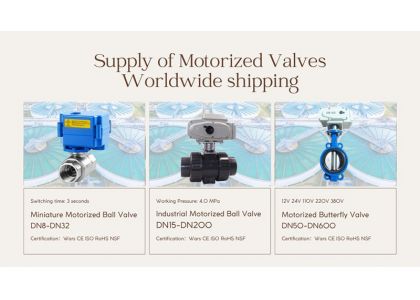
There is no fixed standard for the electric ball valve price.Their cost is determined by numerous factors, and significant price variations exist among electric ball valves of different specifications and functionalities.
This article analyzes from multiple perspectives to help electric ball valve purchasers evaluate prices more accurately.
Valve Body Material
Material is the primary factor determining the price of electric ball valves.
Brass Valves: High hardness, moderate cost, the most common valve material.
Stainless Steel Valves (SS304/SS316): Strong corrosion resistance, high price.
Plastic Valves (UPVC/CPVC): Strong corrosion resistance, lightweight, low cost, but weak pressure resistance.
Cast steel valves: High strength and toughness, capable of withstanding higher working pressures. Higher cost.
Cast iron valves: Suitable only for ambient temperature and low-pressure applications. Lower cost.
The higher the material grade, the higher the price. Generally, stainless steel electric ball valves cost 1.5 to 2 times more than brass ball valves.
Electric Actuator Specifications and Functions
The actuator is a key component of an electric ball valve, and its specifications and functionality directly impact the price.
1. Service life
2. Torque: Higher torque means higher price
3. Power supply type and wiring method
4. IP protection rating
High-performance actuators are often capable of handling more complex operating conditions. Therefore, they come at a higher price.
Valve Size
The larger the valve nominal diameter, the higher the price of the electric ball valve.
DN8-DN25: Miniature electric ball valves, typically used in small-scale automated equipment. Lowest price range.
DN25-DN50: Mid-range pricing.
Above DN50: Industrial-grade electric ball valves requiring higher-torque actuators and capable of withstanding greater working pressures. Highest price range.
Actuator Functions and Wiring Methods
The more complex the functions of an electric ball valve, the higher its price.
Normal On/Off Valves: The most affordable option, offering only basic on/off functionality.
Modulating Valves (0-10V/4-20mA): Capable of angle adjustment, commanding a higher price point.
Smart Valves (WIFI/LoRa/Modbus): Featuring more sophisticated actuators, these represent the most expensive category.
Actuator Torque
Common torque ratings for electric valves: 2Nm, 6Nm, 10Nm, 50Nm, or higher (industrial grade)
Higher torque requires more expensive motors, resulting in higher prices for electric ball valves.
Working Pressure and Temperature
High-temperature media and high-pressure working environments impose stricter requirements on valve sealing materials.
High-pressure valve bodies: PN40 and PN63 models incur higher costs than PN16 valves.
High-temperature media: High-stem motorized ball valves are more expensive than standard motorized ball valves.
OEM/ODM Customization
If motorized valve purchasers require: special wiring lengths, actuator colors, custom brand logos, laser engraving, or separate mold development, these will incur additional costs.
Order Quantity
Large order volumes can significantly reduce the unit price of products.
Sample orders (<10pcd): Typically command higher prices.
Medium batches (100-500): Costs can be reduced by 10-15%.
Large batches (1000+): Eligible for factory-level pricing.
How to get the best price for electric ball valves?
Factors to consider include the valve material, diameter, voltage, wiring configuration, functionality, and working pressure.
To obtain an accurate quote, you typically need to provide the above information so that electric valve suppliers can offer the most precise pricing.